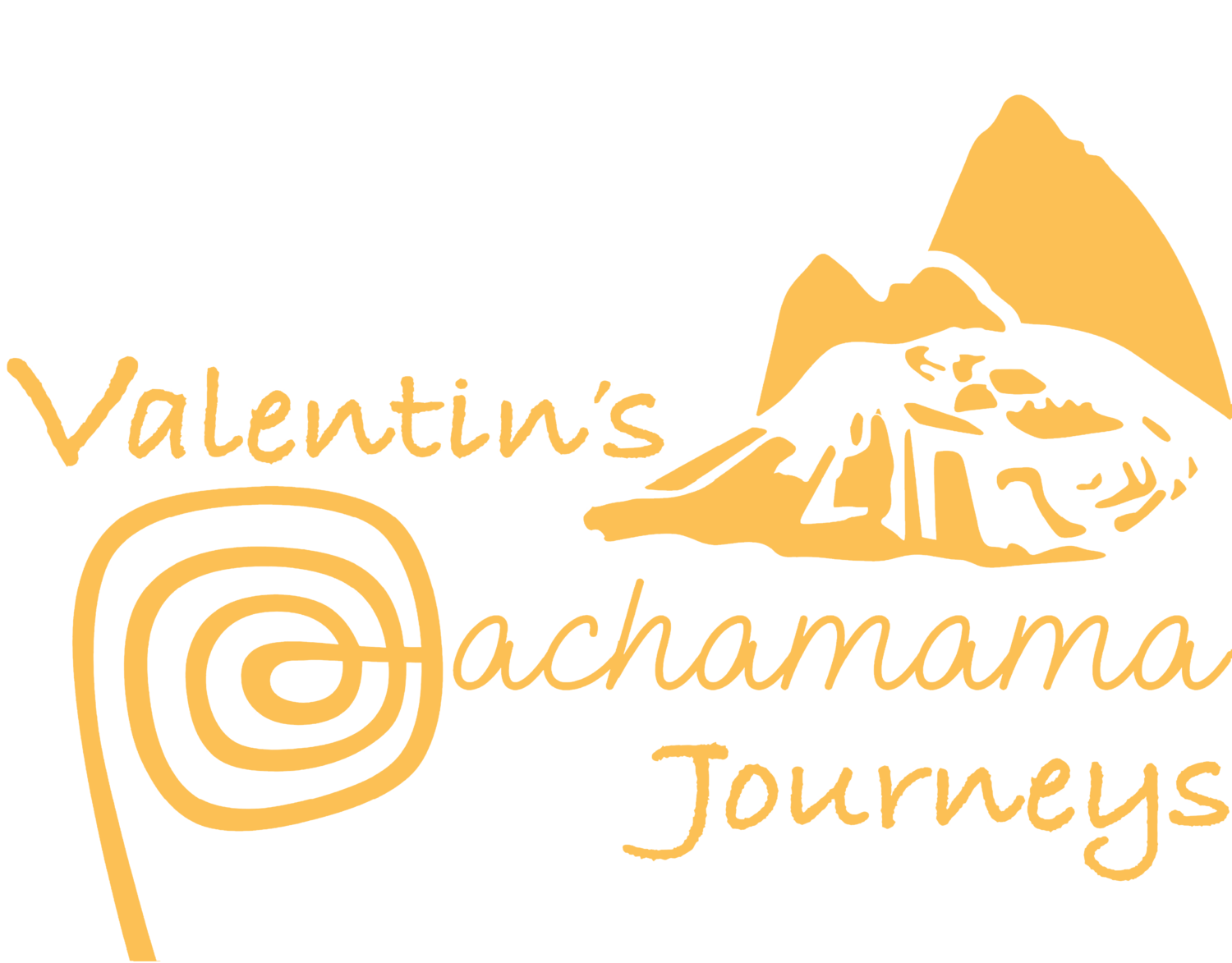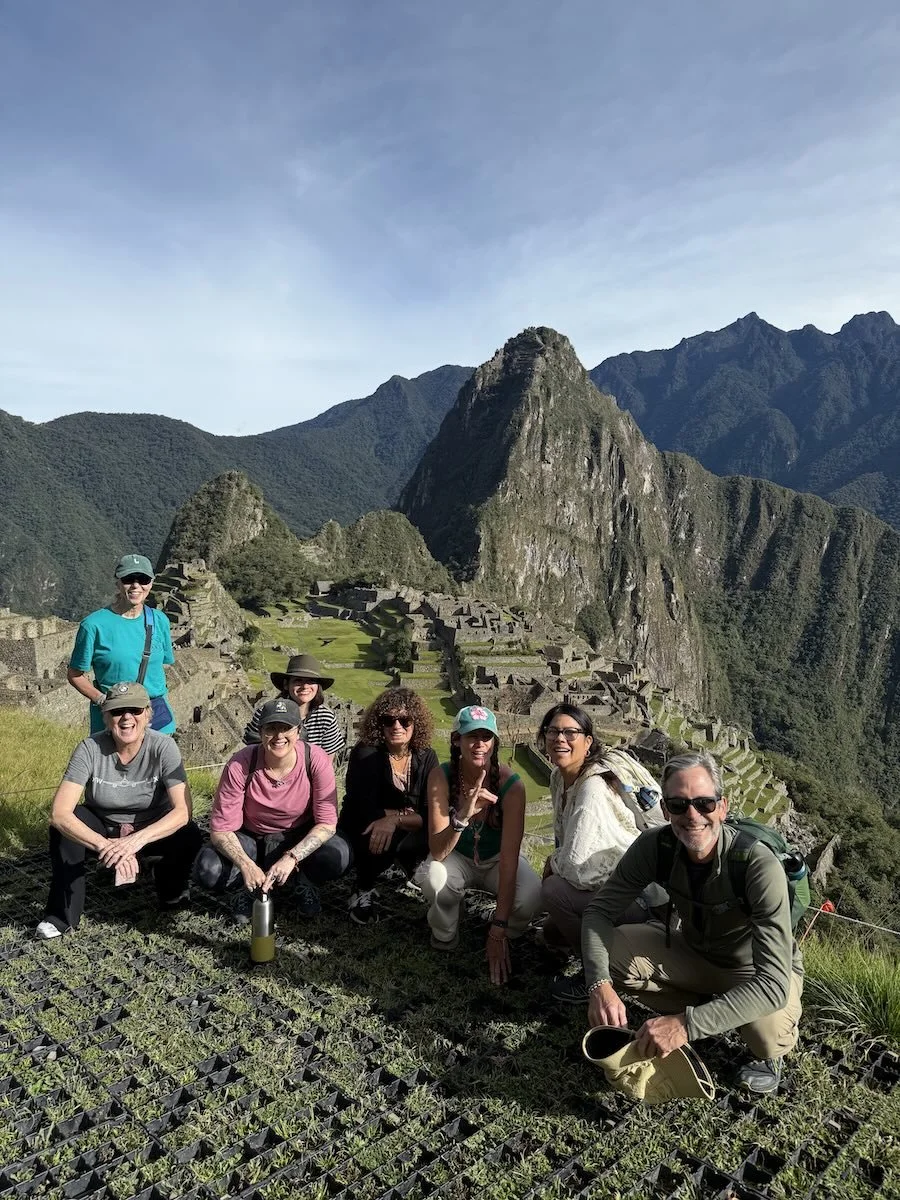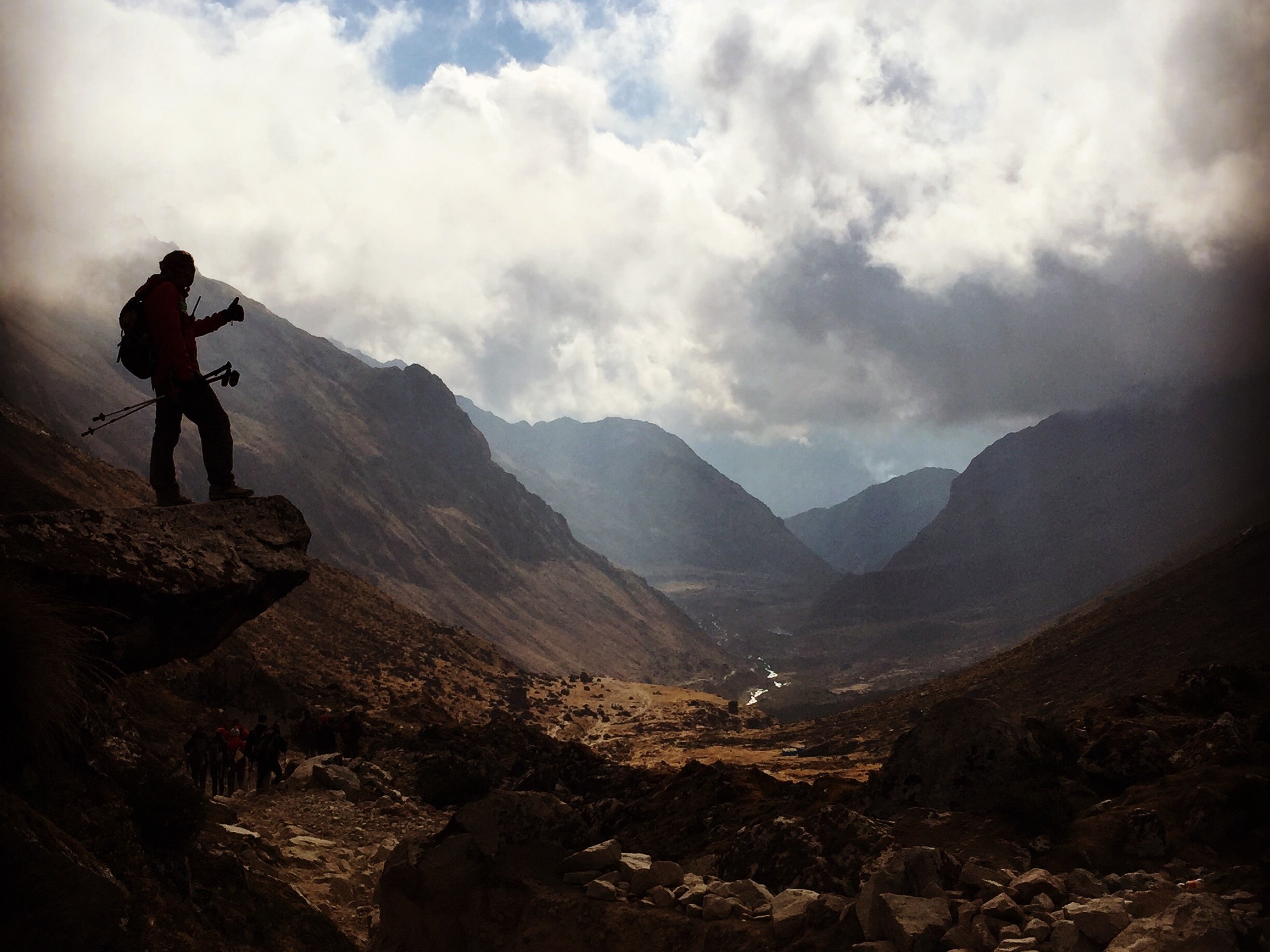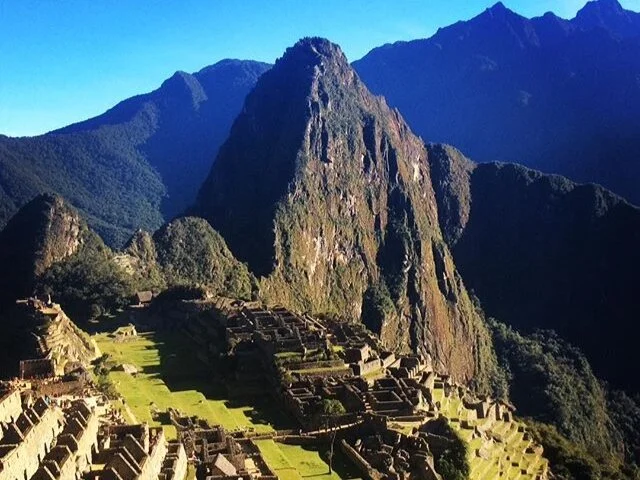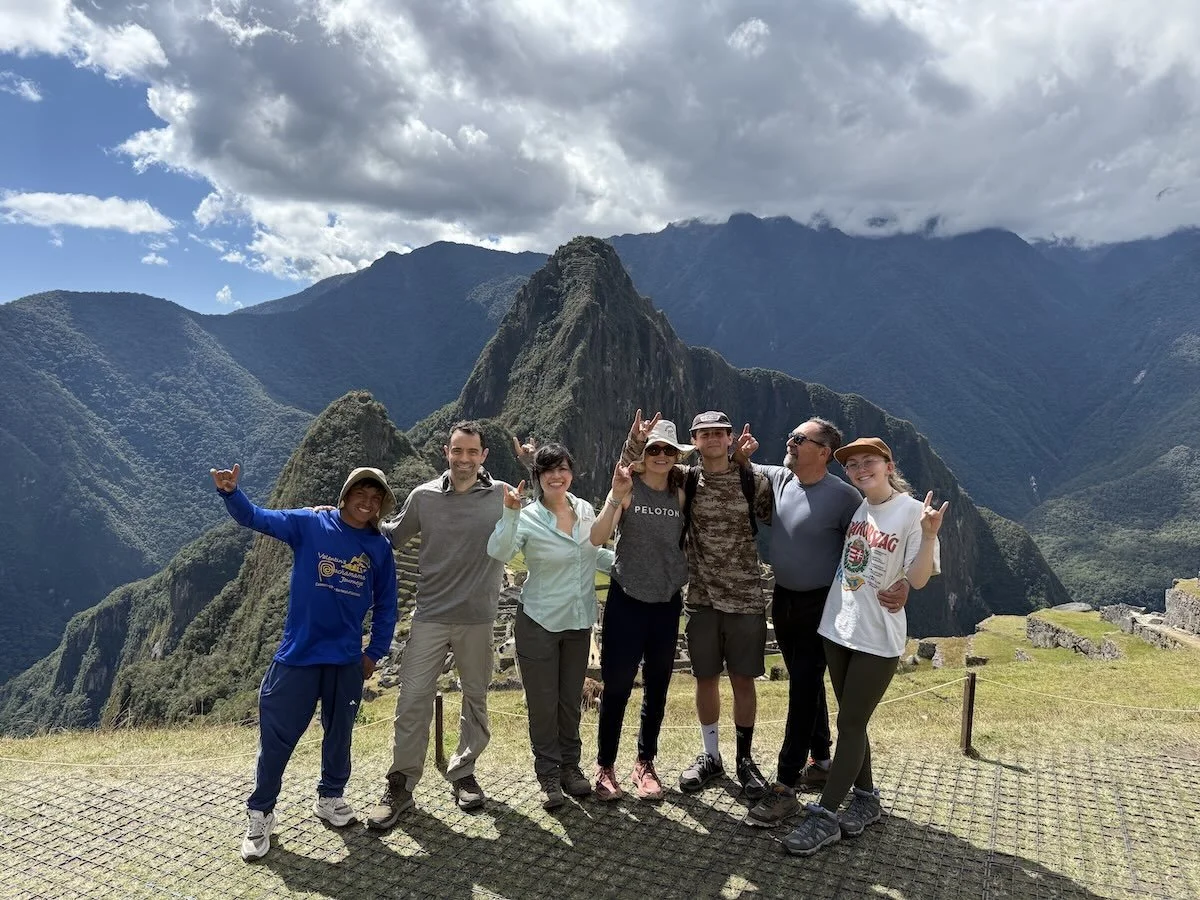Happy Inca Trail trekkers at Machu Picchu ruins, Peru
Inca Trail Hike to Machu Picchu
Cusco’s best Inca Trail tour company
Take on one of the world’s best treks with Cusco’s best tour company—the Inca Trail hike to Machu Picchu.
I, Valentín, know the undulating 42 km (26 miles) route intimately. I worked for many years as an Inca Trail porter. I maintain strong connections with local porter communities through dedication to fair treatment, wages, and social projects.
Let us guide you to the famous Lost City of the Incas, the archaeological treasure that is Machu Picchu, with many more ruins en route.
We’ll pass through beautifully biodiverse areas, from cloud forest to Andean tundra. Orchids line our path and keep a lookout for wildlife like Andean foxes, spectacled bears, and the Cock-of-the-Rock, Peru's national bird.
We offer four or 5-day Machu Picchu trekking tours, and both follow the same route. The 5-day trail travels at a more relaxed pace and stops at more isolated campsites. In contrast, the classic 4-day hike moves more quickly and offers an unforgettable sunrise at the Sun Gate (Inti Punku).
Our Inca Trail package highlights include:
Dead Woman’s Pass
Phuyupatamarka and Wiñay Wayna ruins
Machu Picchu guided tour
Huayna Picchu ticket option
Best guides, porters, and food
We support local social projects
Inca Trail 4-day packages, or 5-day hike
Cusco’s best Inca Trail tour company
4-day Inca Trail itinerary
Day 1: Cusco - Piskacucho Km 82 - Llactapata - Ayapata
We pick you up early from your hotel and drive in our private van to the trailhead at Km 82:
5 am start in Cusco and a 3-hour drive; or
6 am in Ollantaytambo and a 2-hour drive.
Don't worry if you missed breakfast; while the porters organize backpacks, you can enjoy a hot breakfast, the first of many tasty meals to be prepared for you by our talented chef. Sated, we navigate the Inca Trail entry checkpoint, showing the permits we bought alongside your passport.
Our first steps take us across the Urubamba River, which we follow for a couple of hours at an altitude of around 2,720m/8,923ft. Local farmers working their fields or bringing crops to the local market provide the backdrop. When we leave the river, it's for a gentle ascent to the Llactapata ruins.
Llactapata ruins
Llactapata, which means High City in Quechua, is an impressive introduction to Inca ruins. The site, at 2,800m/9,186ft, features agricultural terraces, housing, and the Pulpituyoq ceremonial center.
Hiram Bingham rediscovered Llactapata in 1912. Later studies concluded it was a stopping point en route to Machu Picchu and an important agricultural area.
It’s another two hours of uphill to our lunch stop. On arrival, our team will have everything ready for you to enjoy and regain your strength while you drink in the Andean views. There are two more hours of uphill to our first campsite, Ayapata (3,300m/10,824ft), which we chose for its isolation and stargazing.
Most days, we aim to arrive at camp around 4-5 pm. Porters will pitch your tents while you take a snack and drink. You can socialize with fellow trekkers, the chef, and porters as brothers and sisters before having dinner, usually served around 6-7 pm.
Distance: 8.7 miles/14 km
Hiking time: 6-7 hours
Campsite altitude:3,300m/10,824ft
Elevation: 2,720m-3,300m (8,923ft-10,824ft)
Day 2: Ayapata – Dead Woman´s Pass – Runcuraccay Pass – Chaquiccocha
It’s the first day waking up under canvas, and what better way to start than with a hot coca tea, delivered to your tent by your porters.
Most mountain days involve early starts, and it will be a 5 am wake-up call. Chef provides a hearty breakfast, so we have ample energy to conquer Dead Woman’s Pass, the highest point on our journey to Machu Picchu (4,215m/13,829ft).
The Dead Woman's Pass is one of the grand challenges of the Inca Trail hike. Good acclimatization and positive thinking help us push through the 3.5-hour ascent. The mountain views are breathtaking, as is the porters' pace, as they no doubt overtake us on the way up. Take each step slowly in these high-altitude areas.
The pass brings a well-deserved snack and photo opportunity, and impetus to descend to our lunch spot at around 3,500m/11,482ft. Keep an eye out for hummingbirds flying around. The native Polylepsis tree lines the path, too. We relax and enjoy a sense of achievement before setting off for the second part of this rigorous day.
What goes down must go up, and another ascent awaits, this time to Runkuraqay (4,000m/13,123ft). Here, we visit a small but spectacular Inca ruin and continue learning more about the history at Sayacmarca.
Sayacmarca
Sayacmarca has two areas to visit: a Temple of the Sun and a residential section. The ruins are famous for their canal system and ceremonial baths.
We camp tonight at Chaquicocha, considered one of the most beautiful campsites on the Inca Trail hike. Views of the snow-capped Vilcabamba mountain range and hopefully a fantastic sunset await before a delicious dinner.
Distance: 9.94 miles/16 km
Hiking time: 9 hours
Campsite altitude:3,600 m/11,800ft
Elevation: 3,300m-4,215m-3,600m (10,824ft-13,829ft-11,800ft)
Day 3: Chaquiccocha – Phuyupatamarka - Wiñaywayna
It's a 5.30 am start today, breakfast and a hot drink taken with majestic views and a mountain-backed sunrise. If yesterday was the most challenging day, today is perhaps the most beautiful.
The vegetation changes through the day as we walk to the Atlantic side of the Andes — the Amazon jungle. It's a gentler walk with more downhill and hundreds of Inca steps. Walking poles (rubber-tipped) may be helpful because the number of steps can strain the knees.
The Inca stonework we see today is 100% Inca and includes an original Inca tunnel, which we must pass through as we follow these ancient steps. Today, our first stop is Phuyupatamarka (3,670m/12,040ft), which we reach two hours after breaking camp.
Phuyupatamarka
Phuyupatamarka is known as 'the place above the clouds' and for a good reason. The jungle mists rise up to here, giving the hiker a sensation of floating above the clouds.
Many of the buildings here are intact, featuring six ceremonial baths, stairs, water channels, bridges, and a series of observation platforms. The complex also offers terrific mountain views and a Sacred Valley lookout.
After Phuyupatamarka comes the Inca stairs, some of them steep, around 3,000ft (914m) descent which eventually leads us to Intipata ruins (2,840m/9,300ft). These terraces act as a shortcut to our final campsite, Wiñay Wayna, where our chef and porters will be waiting with a hot lunch for you.
Inca Trail hikers looking over to Winya Wayna
Wiñay Wayna
Wiñay Wayna, Forever Young in Quechua, is one of Peru’s most picturesque Inca archaeological sites, built into a hillside above the Urubamba River.
Agricultural terraces abound, but it is its Temple of the Rainbow, fountains, and stonework that set it apart. Sometimes mist clings to these ruins in the cloud forest, adding to their mystical charm.
After lunch and a siesta, we set off for an in-depth tour of the Wiñay Wayna ruins. Not many take this tour, so we hope to have it to ourselves, allowing us to take amazing photos of this incredible place.
Following dinner, many opt for an early night, replenishing our energy for tomorrow's extensive tour.
Distance: 6.2 miles/10 km
Hiking time: 6 hours
Campsite altitude:2,700m/8,858ft
Elevation: 3,600m-2,700m (11,800ft-8,858ft)
Day 4: Sun Gate/Inti Punku - Machu Picchu
It's the earliest start today—4 am—the earliness softened by your porter bringing you a hot coca tea to your tent.
We have a quick breakfast so we can get to the checkpoint early and be one of the first groups to arrive at the Sun Gate, Inti Punku (2,745m / 9,005ft).
A gentle, hour-long trail leads us towards Machu Picchu. Your first view of the citadel is the most special. After photos, we descend another hour and are among the Machu Picchu ruins, ready for our 2.5-hour tour. Have your camera ready.
Highlights include:
Intihuatana (Sun Clock): Beautiful sundial carved into the rock.
The Temple of the Sun: An enormous rock and the most sacred of all Machu Picchu’s temples.
Temple of the Condor: A natural rock formation sculpted into a magnificent flying condor image.
Temple of the Three Windows: A temple in Machu Picchu’s Sacred Plaza.
Exploring Wiñay Wayna ruins on the Inca Trail trek in Peru
Huayna Picchu
You need to buy a permit (limited in number) to climb Huayna Picchu, and it sells out well in advance. Please ask us for more information.
It is well worth the entry fee. It’s an energetic 1-2-hour walk to the top, with steep staircases and steel cables at points. In wet weather, it can be slippery.
Once you reach the top, you have a new and wonderful perspective of Machu Picchu. Huayna Picchu also offers access to the Temple of the Moon, one of the three main temples at Machu Picchu.
The peak of Huayna Picchu sits at 2,693m/8,835ft, around 260m/850ft higher than Machu Picchu.
Huayna Picchu is not recommended for people with vertigo or a fear of heights. There are some steep stairs and vertiginous areas.
Machu Picchu Mountain
Like Huayna Picchu, you need a pre-bought permit for Machu Picchu Mountain. It doesn’t sell out as fast, but it is still recommended to buy the ticket as soon as possible.
The Machu Picchu Mountain trek is considered a moderate-to-challenging hike. You follow an original stone Inca Trail up to its peak, at 3,082m/10,111ft, which offers breathtaking views of the ruins and the valleys, and is 652m/2,139ft above Machu Picchu.
We recommend around 90 minutes to climb up and an hour to descend. During the wet season, the trail can become more slippery. Again, this is not suitable for people with a fear of heights - in places, the track is very steep and often follows the mountain edge.
Return to Ollantaytambo/Cusco
We return to Aguas Calientes by bus and, if you have time, you may visit the town’s hot springs. It’s well worth paying the entry fee for an hour or two to soak in the warm waters.
Don’t forget to read our FAQs, covering altitude, money, and more.
Inca Trail trek prices (4 days)
Minimum two people
Groups of 2: $1,140 per person
Groups of 3: $959 per person
Groups of 4: $895 per person
Groups of 5: $890 per person
Groups of 6: $860 per person
Groups of 7 or more: $790 per person
Inca Trail: What’s included?
Entrance to Inca Trail and Machu Picchu, bus between Machu Picchu and Aguas Calientes, tourist class train from Aguas Calientes to Ollantaytambo (Vistadome available for extra $55pp one way, $110pp return), private transport between your hotel in Cusco to start of trek, return to Poroy, duffel bag for your belongings to be carried by porters up to 6kg per person, all meals except lunch on day 4 in Aguas calientes, personal porter who carries your belongings and sets up and takes down your tent nightly, certified professional English-speaking guide, certified chef experienced in cooking vegetarian meals and accommodating special diets and allergies, good quality tent for sleeping, private bathroom tent and chemical toilet for your group only so that you don’t have to use the toilets along the Inca trail, snacks, purified water except for on day 1 (please bring your own water this day), & oxygen tank.
Inca Trail: What’s not included?
Water day 1, Lunch day 4 in Aguas Calientes, alcohol, gratuities, Huayna Picchu ($75 per person), inflatable mattress ($20 extra), sleeping bag ($20 extra), trekking poles ($20 extra).
Inca Trail: What to bring?
Original passport that was used to make the reservation for the Inca trail, head lamp, day pack, sunscreen, Insect repellent, & any prescription medication.
5-day Inca Trail itinerary
The 5-day Inca Trail is ideal for families or anyone concerned about the physical condition required for the 4-day Inca Trail trek.
The route is the same, and you won't miss out on any of the highlights. We walk at a more relaxed pace than the classic 4-day hike, with fewer early starts and visits to ruins at quieter times, often with just our group.
The Sun Gate arrival is in the afternoon, giving beautiful views. Machu Picchu is also much less crowded. You spend the final night in a hotel, sleeping well, recovering from the walk with a trip to the hot springs or a massage before the next day’s tour of the ruins.
Day 1: Cusco/Ollantaytambo to Llactapacta
We can pick you up from your hotel in Cusco or Ollantaytambo at 8 am.
From Cusco: 3-hour drive to the trailhead for lunch.
From Ollantaytambo: Tour of Ollantaytambo ruins, then drive to the trailhead for lunch.
Cusco pick-ups will stop briefly in Ollantaytambo to use the bathroom and buy snacks.
Ollantaytambo pick-ups have a private guided tour of the Ollantaytambo site. We will climb to visit the Temple of the Sun and enjoy breathtaking views of the Sacred Valley.
Ollantaytambo
Ollantaytambo is one of the best-preserved Inca towns in all of Peru. Many of the original 15th-century buildings are still standing. Ollantaytambo was an important town—it was home to the Inca emperor Pachacutec—and was the base for military victories against the Spanish.
We explore the exquisite terracing, fountains, aqueducts, and ruins that surround the town. A highlight is Temple Hill with its Sun Temple and the impressive Wall of the Six Monoliths. The Pinkuylluna Inca storehouses are also spectacular.
Start of the 5-day Inca Trail hike
Both itineraries converge at lunchtime, where we have a picnic lunch at the beginning of the trail. Sated, we navigate the Inca Trail entry checkpoint, showing the permits we bought alongside your passport.
Our first steps take us across the Urubamba River, which we follow for a couple of hours at an altitude of around 2,720m/8,923ft.
After lunch, we will walk along the Urubamba River to Llactapacta, where we will camp for the night in front of a beautiful Inca archaeological site by the river.
Llactapata ruins
Llactapata, which means High City in Quechua, is an impressive introduction to Inca ruins. The site, at 2,800m/9,186ft, features agricultural terraces, housing, and the Pulpituyoq ceremonial center.
Hiram Bingham rediscovered Llactapata in 1912. Later studies concluded it was a stopping point en route to Machu Picchu and an important agricultural area.
Hiking time: 2 hours
Campsite altitude:2,800/9,168ft
Elevation: 2,720m-2,800m (8,923ft-9,168ft)
Day 2: Llactapacta to Llulluchapampa
Porters wake you at 6.30 am with a cup of hot coca tea, delivered to your tent by your porters.
We start the day by exploring the archaeological site of Llactapacta, one of the most magical places along the Inca Trail.
We head up the Cusichaca valley next, passing through communities that preserve much of the Inca lifestyle. We can stop by a local house, try Chicha, a traditional maize beer, and feed the families' guinea pigs.
Our route means the next 3 hours are a gradual climb, followed by a steep hour to our lunch spot. Hopefully, there will be time for a siesta before the second part of the day's walk, a 2-hour ascent on Inca stairs to our campsite at Llulluchapampa (3,800m/12,500ft).
Llulluchapampa is a small and beautiful campsite frequented by few, nestled just below the Inca Trail’s highest point, the Dead Woman’s Pass (4,215m/13,829ft). From the camp, there are stunning views of the Huayanay mountain.
We have a hearty dinner and enjoy being in this remote gem of a place.
Day 3: Llulluchapampa to Puhphuypatamarca
Mountain days may involve early starts, and today it's a 5.30 am wake-up call. Chef provides a hearty breakfast, so we have ample energy to conquer Dead Woman's Pass, the highest point on our journey to Machu Picchu (4,215m/13,829ft).
The Dead Woman's Pass is one of the grand challenges of the Inca Trail hike. Good acclimatization and positive thinking help push us along. The mountain views are breathtaking.
The pass brings a well-deserved snack, photo opportunity, and impetus to descend to our lunch spot at Chaquicocha. Keep an eye out for hummingbirds flying around on this part of the trail. Native Polylepsis trees line the path, too.
Two Inca ruins await us en route—Runkuraqay (4,000m/13,123ft)—a small but spectacular Inca ruin, and Sayacmarca, with a Temple of the Sun, canal system, and ceremonial baths.
Our campsite is Puhphuypatamarca, by far the most beautiful camp along the Inca Trail. From here, there are 360-degree views of the Andes and the night sky, including the Milky Way.
Day 4: Puhphuypatamarca - Machu Picchu - Aguas Calientes
Wake early at 05:30 to enjoy a stunning sunrise and see the sun's rays hitting the snowy mountains of Salkantay, Pumasillo, and Veronica. After breakfast, we explore Phuyupatamarka.
Phuyupatamarka
Phuyupatamarka is known as 'the place above the clouds' and for a good reason. The jungle mists rise to here and give the hiker a sensation of floating above the clouds.
Many of the buildings here are intact, featuring six ceremonial baths, stairs, water channels, bridges, and a series of observation platforms. The complex also offers lovely mountain views and a Sacred Valley lookout.
After Phuyupatamarka come the Inca stairs, some of them steep, with a descent of around 3,000ft (914m), which eventually lead us to the Intipata ruins (2,840 m/9,300 ft). These terraces act as a shortcut to Wiñay Wayna, where we have lunch.
Wiñay Wayna
Wiñay Wayna, Forever Young in Quechua, is one of Peru’s most picturesque Inca archaeological sites, built into a hillside above the Urubamba River.
Agricultural terraces abound, but it is its Temple of the Rainbow, fountains, and stonework that set it apart. Sometimes mist clings to these ruins in the cloud forest, adding to their mystical charm.
After lunch, a gentle, hour-long trail leads us towards Machu Picchu, arriving first at Sun Gate, Inti Punku (2,745m / 9,005ft). Your first view of the citadel is the most special.
Cross through the Inti Punku, and on the other side, the archaeological wonder that is Machu Picchu spreads out beneath your gaze. What was once a fortress to monitor those entering Machu Picchu now offers the most pleasing view of the ruins, some 300m/985ft below.
The Incas, of course, built more into the Sun Gate than just a watchpoint for people approaching from Cusco. On a ridge above Machu Picchu, its south-easterly location means the sun passes through the gate each summer solstice.
We avoid the early-morning crowds by arriving in the afternoon, giving you time to gaze at Machu Picchu and get the perfect picture. Satisfied, we descend towards the ruins but then fork right. We’ll then catch a bus at the Machu Picchu entrance down to Aguas Calientes and our hotel.
Dinner is included at a local organic restaurant, followed by a refreshing sleep before tomorrow's extensive tour.
Day 5: Machu Picchu — Ollantaytambo/Cusco
Today, we explore the Lost City of the Incas—Machu Picchu.
It’s an early start because we want to enjoy the sunrise at Machu Picchu. We wake up at 05:30 and have breakfast at 06:00. We’ll board a bus for the 20-minute bus ride to the Machu Picchu ruins entrance, passports in hand for the checkpoint.
Your guide will take you on a two-and-a-half-hour tour around one of the world's most important temples. Have your camera ready.
Highlights include:
Intihuatana (Sun Clock): Beautiful sundial carved into the rock.
The Temple of the Sun: An enormous rock and the most sacred of all Machu Picchu’s temples.
Temple of the Condor: A natural rock formation sculpted into a magnificent flying condor image.
Temple of the Three Windows: A temple in Machu Picchu’s Sacred Plaza.
Huayna Picchu
You need to buy a permit (numbers limited) to climb Huayna Picchu, and it does sell out a long way in advance. Please ask us for more information.
It is well worth the entry fee. It’s an energetic 1-2-hour walk to the top, with steep staircases and steel cables at points. In wet weather, it can be slippery.
Once you make it to the top, you have a new and wonderful perspective of Machu Picchu. Huayna Picchu also offers access to the Temple of the Moon, one of the three main temples at Machu Picchu.
The peak of Huayna Picchu sits at 2,693m/8,835ft, around 260m/850ft higher than Machu Picchu.
Huayna Picchu is not recommended for people with vertigo or a fear of heights. There are some steep stairs and vertiginous areas.
Machu Picchu Mountain
Like Huayna Picchu, you need a pre-bought permit for Machu Picchu Mountain. It doesn’t sell out as fast, but it is still recommended to buy the ticket as soon as possible.
The Machu Picchu Mountain trek is considered a moderate-to-challenging hike. You follow an original stone Inca Trail up to its peak, at 3,082m/10,111ft, which offers breathtaking views of the ruins and the valleys, and is 652m/2,139ft above Machu Picchu.
We recommend around 90 minutes to climb up and an hour to descend. During the wet season, the trail can become more slippery. Again, this is not suitable for people with a fear of heights - in places, the track is very steep and often follows the mountain edge.
Return to Ollantaytambo/Cusco
We return to Aguas Calientes by bus and, if you have time, you may visit the town’s hot springs. It’s well worth paying the entry fee for an hour or two to soak in the warm waters.
Inca Trail trek prices (5 days)
Groups of 2: $1,235 per person
Groups of 3: $1,140 per person
Groups of 4: $1,035 per person
Groups of 5: $ 980 per person
Groups of 6: $ 935 per person
Groups of 7: $ 895 per person
Groups of 8 or more: $855 per person
Inca Trail: What’s included?
All meals, except lunch on day 5, porter service, tents, private guide, entrance to the Inca Trail and Machu Picchu, bus tickets from Machu Picchu to Aguas Calientes, train tickets from Aguas Calientes to Ollantaytambo (Vistadome available for extra $55pp one way, $110 pp return), private transfer to and from the hotel (door to door service), foam mattress.
Inca Trail: What’s not included?
Lunch on day 5, alcohol, tips, Hauyna Picchu ($ 75 per person), inflatable mattress $ 20 extra, sleeping bag $ 20 extra, trekking poles $ 20 extra
Suggested tours nearby
Inca Trail trek gallery
<- BACK
